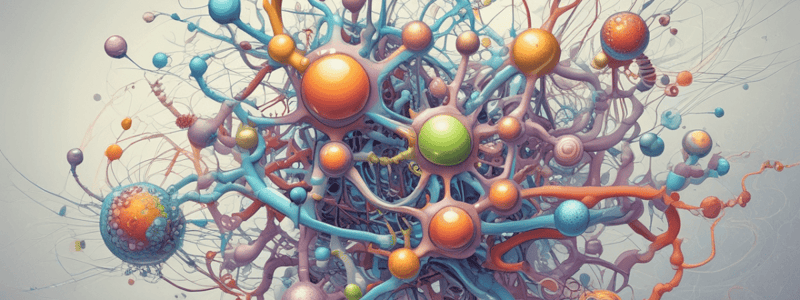Podcast
Questions and Answers
What is the primary function of transmembrane receptors in cellular signalling?
What is the primary function of transmembrane receptors in cellular signalling?
- To activate gene expression in response to extracellular signals (correct)
- To facilitate the breakdown of glycogen in the liver
- To synthesise glucagon in response to adrenaline
- To release histamine from mast cells
Which of the following is NOT an example of a second messenger?
Which of the following is NOT an example of a second messenger?
- Diacylglycerol
- cAMP
- Glucagon (correct)
- Inositol triphosphate (IP3)
What is the primary function of G proteins in signal transduction pathways?
What is the primary function of G proteins in signal transduction pathways?
- To transmit signals from transmembrane receptors to intracellular signalling pathways (correct)
- To stimulate the release of histamine from mast cells
- To activate receptor tyrosine kinases
- To synthesise prostaglandins from arachidonic acid
Which of the following is an example of a cellular response to extracellular signals?
Which of the following is an example of a cellular response to extracellular signals?
What is the role of phospholipase C in signal transduction pathways?
What is the role of phospholipase C in signal transduction pathways?
Which of the following is an example of an extracellular signal that binds to a transmembrane receptor?
Which of the following is an example of an extracellular signal that binds to a transmembrane receptor?
What is the role of Receptor Tyrosine Kinase (RTK) in signal transduction pathways?
What is the role of Receptor Tyrosine Kinase (RTK) in signal transduction pathways?
Which of the following is an example of a cellular response to extracellular signals that involves changes in gene expression?
Which of the following is an example of a cellular response to extracellular signals that involves changes in gene expression?
What is the primary characteristic of a paracrine signal?
What is the primary characteristic of a paracrine signal?
Which type of receptor is typically associated with hydrophilic hormones such as adrenaline?
Which type of receptor is typically associated with hydrophilic hormones such as adrenaline?
What is the primary difference between autocrine and paracrine signaling?
What is the primary difference between autocrine and paracrine signaling?
What is a characteristic of receptors in terms of their binding to signals?
What is a characteristic of receptors in terms of their binding to signals?
Which type of signaling involves the direct interaction between two cells?
Which type of signaling involves the direct interaction between two cells?
What is a characteristic of signals in terms of their binding to different receptors?
What is a characteristic of signals in terms of their binding to different receptors?
What is the primary mechanism of action for steroid hormones?
What is the primary mechanism of action for steroid hormones?
What is the effect of acetylcholine binding to its receptor?
What is the effect of acetylcholine binding to its receptor?
What is the function of the DNA binding domain in steroid hormones?
What is the function of the DNA binding domain in steroid hormones?
What is the role of G-protein-coupled receptors in signaling pathways?
What is the role of G-protein-coupled receptors in signaling pathways?
What is the effect of glucagon binding to its receptor?
What is the effect of glucagon binding to its receptor?
What is the function of the hormone binding domain in steroid hormones?
What is the function of the hormone binding domain in steroid hormones?
What is the effect of EGF binding to its receptor?
What is the effect of EGF binding to its receptor?
What is the role of phospholipase C in signaling pathways?
What is the role of phospholipase C in signaling pathways?
What is the main function of the G-protein α subunit when GTP is bound to it?
What is the main function of the G-protein α subunit when GTP is bound to it?
What is the result of the GTPase activity on the G-protein α subunit?
What is the result of the GTPase activity on the G-protein α subunit?
What is the function of the βγ subunit in the G-protein complex?
What is the function of the βγ subunit in the G-protein complex?
What is the result of the signal binding to the receptor in GPCR signalling?
What is the result of the signal binding to the receptor in GPCR signalling?
What is the function of the effector enzyme in GPCR signalling?
What is the function of the effector enzyme in GPCR signalling?
What is the purpose of the GTP/GDP exchange on the G-protein?
What is the purpose of the GTP/GDP exchange on the G-protein?
What is the outcome of GTP hydrolysis in the G-protein complex?
What is the outcome of GTP hydrolysis in the G-protein complex?
What is the role of cAMP in the activation of protein kinase A (PKA)?
What is the role of cAMP in the activation of protein kinase A (PKA)?
What is the effect of phosphorylase kinase a on glycogen?
What is the effect of phosphorylase kinase a on glycogen?
What is the role of phosphodiesterase in the regulation of cAMP levels?
What is the role of phosphodiesterase in the regulation of cAMP levels?
What is the outcome of CREB phosphorylation by PKA?
What is the outcome of CREB phosphorylation by PKA?
What is the outcome of IP3 binding to the Ca2+ channel in the endoplasmic reticulum?
What is the outcome of IP3 binding to the Ca2+ channel in the endoplasmic reticulum?
What is the role of DAG in the activation of protein kinase C?
What is the role of DAG in the activation of protein kinase C?
What is the outcome of signal amplification via kinase cascade?
What is the outcome of signal amplification via kinase cascade?
What is the role of Gαq (Gq) subunit in the GPCR pathway?
What is the role of Gαq (Gq) subunit in the GPCR pathway?
What is the outcome of the binding of cAMP to the regulatory subunit of PKA?
What is the outcome of the binding of cAMP to the regulatory subunit of PKA?
Flashcards are hidden until you start studying
Study Notes
Cell Biology and Signalling
- The course covers the foundations of medical science, specifically cell biology and signalling.
Cellular Responses
- Cellular responses to signals include:
- Change in metabolic activities (e.g. glucagon switches liver from synthesizing glycogen to breaking down glycogen)
- Secrete and release (e.g. binding of antigen to mast cell stimulates the secretion of histamine)
- Changes in gene expression (e.g. Epidermal Growth Factor (EGF) activating genes involved in cell growth)
- Sensory perception (e.g. light activation of rhodopsin)
Extracellular Signals
- Factors that act as extracellular signals include:
- Amino acids (and derivatives) (e.g. glutamate, adrenaline, dopamine)
- Steroids (e.g. oestradiol, testosterone, cortisol, aldosterone)
- Prostaglandins (eicosanoids) derived from arachidonic acid
- Proteins and Peptides (e.g. insulin, glucagon, growth factor, EGF)
- Gases (e.g. NO, CO)
Ways for Cells to Signal to Each Other
- Different ways for cells to signal to each other include:
- Endocrine (signal produced by cells in one part of the body and travels in blood to target cells somewhere else)
- Autocrine (signal acts on the same cell that produces it)
- Paracrine (signal produced by cell and acts on other cells that are very close)
- Contact dependent (signal is integral part of one cell and interacts directly with another cell)
- Neuronal (electrical signal transmitted down cell and message passed to another via synapse)
Receptor/Signal
- A cell must express a receptor in order to respond to a signal
- Receptors have high selectivity and high affinity
- Signals can bind to different types of receptors
- Signals are eventually turned off
Location of Receptors
- Cell surface receptors (e.g. hormone is hydrophilic, binding of hormone triggers response inside cell)
- Intracellular receptors (e.g. hormone is hydrophobic, hormone crosses the plasma membrane, hormone binds to receptor in the cytosol and triggers a response inside cell)
Types of Signalling
- Binding of signal to receptor:
- Depolarization of membrane due to flow of ions (e.g. acetylcholine)
- Direct activation of transcription factor (e.g. steroid)
- Generation of secondary message inside cell (e.g. glucagon – cAMP)
- Direct activation of enzymatic kinase cascade (e.g. EGF – MAP kinase pathway)
Second Messengers
- Cyclic AMP (cAMP)
- Cyclic GMP (cGMP)
- Inositol 1, 4, 5-trisphosphate (IP3)
- Diacylglycerol (DAG)
- Calcium ions (Ca2+)
G-Protein-Coupled Receptors
- G-protein-coupled receptors (GPCRs) have 7 transmembrane-spanning domains
- Activation of GPCRs leads to the activation of G-proteins
- G-proteins are guanine nucleotide binding proteins
G-Protein Signalling
- G-protein signalling involves:
- Signal binding to receptor
- G-protein (GDP bound) associates with receptor
- GTP/GDP exchange on G-protein (GTP bound)
- G-protein dissociates into α (GTP bound) and βγ subunits
- α subunit (with GTP bound) activates effector enzyme
- Effector enzyme produces 2nd messenger
- GTP hydrolysed to GDP, G-protein complex re-associates, signalling ends
cAMP Signalling
- cAMP is a second messenger produced by the activation of adenylyl cyclase
- cAMP activates protein kinase A (PKA)
- PKA phosphorylates and activates target proteins
cAMP Dependent Protein Kinase A (PKA)
- PKA is a tetrameric enzyme consisting of 2 regulatory (R) and 2 catalytic (C) subunits
- cAMP binds to the regulatory subunit and tetramer dissociates
- Catalytic monomers (C) are now active enzymes
cAMP Mediated Effects on Glycogen Breakdown
- cAMP dependent protein kinase (PKA) phosphorylates and activates phosphorylase kinase
- Phosphorylase kinase phosphorylates and activates phosphorylase
- Phosphorylase breaks down glycogen to glucose-1-phosphate
Signal Amplification via Kinase Cascade
- Signal amplification occurs through the activation of multiple enzymes in a kinase cascade
- The numbers of molecules involved in each step of the cascade increase, amplifying the signal
cAMP and Gene Transcription
- PKA phosphorylates CREB (cAMP response element binding protein)
- CREB binds to specific sequences in target genes and stimulates transcription
- Long-term adaptation to starvation involves changes in gene expression
Studying That Suits You
Use AI to generate personalized quizzes and flashcards to suit your learning preferences.




